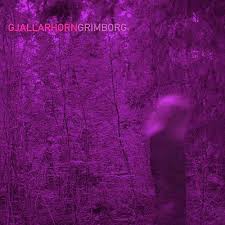 What is it about Nordic folk music that draws you? Is it the wailing fiddles, the slight dissonance that seems to tap into something very basic? Is it the melodies, the lilt to the tunes? And Gjallarhorn’s magic? Was it the wild cant to the songs that married didgeridoo, fiddle and wild percussion? Or was it the evocative strings? Dear Reader, if you haven’t yet had the Gjallarhorn experience, you’ve missed out! Their debut Ranarop was only surpassed by their sophomore effort, Sjofn. Both discs blended themes of nature and magic while incorporating the best of world music influences into their Finnish-Swedish folk repertoire. It was difficult not to rave about a mix of songs that was accessible yet seemed to provide a glimpse of a far older era, a time when the forces of nature were intimately and personally connected to the human world. Vocalist Jenny Willhelms summoned these forces with her voice, while her whole persona emanated the qualities of some reborn Scandinavian deity, at once both inviting and forbidding.
What is it about Nordic folk music that draws you? Is it the wailing fiddles, the slight dissonance that seems to tap into something very basic? Is it the melodies, the lilt to the tunes? And Gjallarhorn’s magic? Was it the wild cant to the songs that married didgeridoo, fiddle and wild percussion? Or was it the evocative strings? Dear Reader, if you haven’t yet had the Gjallarhorn experience, you’ve missed out! Their debut Ranarop was only surpassed by their sophomore effort, Sjofn. Both discs blended themes of nature and magic while incorporating the best of world music influences into their Finnish-Swedish folk repertoire. It was difficult not to rave about a mix of songs that was accessible yet seemed to provide a glimpse of a far older era, a time when the forces of nature were intimately and personally connected to the human world. Vocalist Jenny Willhelms summoned these forces with her voice, while her whole persona emanated the qualities of some reborn Scandinavian deity, at once both inviting and forbidding.
Gjallarhorn are Jenny Willhelms on vocals, violin and hardanger fiddle; Christopher Öhman on viola, mandola, vocals and kalimba; Tommy Mansikka on aho, didgeridoo, mungiga, udu and djembe; and David Lillkvist on percussion and kaliba. The band have built a solid following here in North America, with tours and appearances that have drawn the attention of both fans and press.
And what about Grimborg, you ask? Well, if depends on your answer to my original question. Grimborg resonates with wild, dissonant strings, making it a darker album than its sisters, both mysterious and demanding the listener’s attention. Sjofn concentrated on the springtime themes of love and fertility, but Grimborg seems well suited to its release date in the late fall. But if you’re looking for more accessible, danceable tunes about friendly goddesses, Grimborg may disappoint. As their Web site tells us, “The lyrics of the medieval ballads on this album are all about transformations; first to hide one’s true face, to conquer obstacles on the way, to discover the underground/the subconscious, and to finally rediscover one’s right element. This could be the equivalent to “entering a grimborg”; which is an old ritual practised in Finland in the past when people trod the stone mazes, found all along the shoreline. In the maze ritual the difficulty lies in reaching the centre, where the maiden is, after which you exit the maze together with her. Grim comes from the word grímr, which means concealing, a person who hides his true name. Borg stands for the stronghold, the dwelling.”
Make no mistake, this is heady stuff, and both the music and the themes seem to be more complicated and difficult than previous efforts. I’m afraid my advance copy did not contain the lyrics, so I can’t comment on the content of individual songs. I will say that the album builds slowly, and the tracks are suggestive of introspection rather than celebration. The strings are up front and centre, creating a dark sense of the foreboding and mystery.
The title track, is reminiscent of the material on Sjofn in that it combines Willhelms’ vocals with an insistent cello and lilting, danceable melody. I also liked “Tora lille – Little Tora” for its combination of fiddle and vocals. It is difficult to walk away from this music; it creates a compelling sense of discomfort with lilting melodies and insistent strings weaving together with world beat rhythms. “Herr Olaf – Sir Olaf” creates a dynamic sense of tension, as Willhelms’ voice ranges from tender to shrill around a difficult melody, dancing above a prominent discussion dominated by shakers, rainstick and didgeridoo. “Ack Lova Gud – Oh, Praise the Lord” is a haunting, lonely chant where Willhelms and the viola create a sense of desolation and intensity. For many, the vocal high point on Grimborg will be “Kulning – Cow Calling” for its shrieking, intense vocals.
For me, Grimborg’s most compelling moments are the instrumentals. There is dark discord in “Polonaise,” this time with a mediaeval flavour; the didgeridoo creates a punctuated, breathy drone. The sense of alluring unease continues with “Menuet – Minuet/Njawara,” another tune with melodic themes reminiscent of previous efforts, though with a heightened sense of contrast and dissonance. I also particularly enjoyed “Frøysnesen/Soteroen” for their drama and the strong influence of strings and didgeridoo.
If you like Gjallarhorn for their complicated, sometimes forbidding strings, you’ll love Grimborg, with it’s dark, transformative sound. If you like Gjallarhorn as a nordic-world dance band with easygoing, nature-loving themes, Grimborg may prove to be more difficult for you. As for me, although I was initially surprised, I have come to love this tense, compelling music. I find it to be the perfect antidote to a sugarcoated holiday season, a perfect companion for the short days and long nights that incubate transformations that only later become apparent when the sun returns in the spring.
(Northside, 2002)
